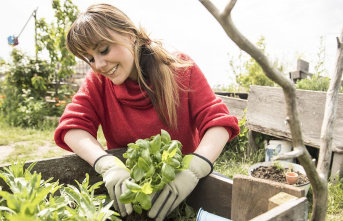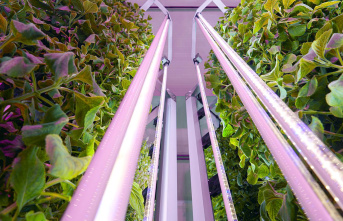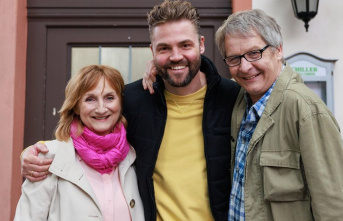The hills, the valleys, the sky. And the old longing for the quiet country of home. Every one of us knows it. And then you see it somewhere in Germany, e.g. a little south of the Main in the lovely landscape of Franconia: the Steigerwald.
A gently rolling topography, beech forests with scattered orchards and villages that are still villages and not residential satellites, farms, lots of old half-timbered houses and church towers like exclamation marks. The impressions are complemented by the attractive geometric pattern of vineyards.
There should be people who can taste the landscape at such a sight. In this case, hearty delights such as bratwurst on sauerkraut, sour Zipfel - bratwurst in an onion and vinegar broth -, Schäufele (braised pork shoulder) with plenty of sauce and dumplings or baked carp come to mind, dishes that are typical of Franconia.
But how about this: foie gras mousse and terrine with marinated mirabelle plums, blueberries and pistachio crunchy? There is no hallucination, the Franconian Steigerwald has not dressed up as the southwestern French Périgord. Rather, the man who devised this fine dish is a real kid from the area. Steffen Szabo comes from Weigenheim, an ancient village with almost 1,000 inhabitants in the district of Neustadt an der Aisch - Bad Windsheim. He says he can only "breathe in the midst of beautiful nature between vineyards and forests". A remarkable sentence for a 32-year-old.
Steffen Szabo is a chef. He worked in renowned restaurants during his apprenticeship and travel years, his kitchen was awarded a Michelin star in 2016 and 2020, and at 26 he was Bavaria's youngest star chef. He loves French cuisine - and he loves his Franconian homeland. So he combines both, which leads to wonderful results: to culinary highlights.
Szabo doesn't use his culinary skills on just any stove in the provinces, but rather puts the crown on an architectural jewel of his homeland: he is the chef at "Le Frankenberg", the new fine-dining restaurant at Schloss Frankenberg. Here he wants to get the stars from the Michelin sky and let them shine from afar on the towers and battlements of the castle.
This historically significant property stands out even in this historically turbulent region, which is also characterized by numerous medieval communities such as Ochsenfurt am Main in the north or Rothenburg ob der Tauber in the south, which boasts itself as "the most beautiful small town in Germany". The first sight of Frankenberg Castle is like something out of a fairy tale: it rises above the wide hilly landscape like an enchanted knight's castle, flanked by steep vineyards.
Its origins date back to the 12th century. During the Reformation, the Frankish Knights of Hutten, whose best-known representative was the poet and church critic Ulrich von Hutten (1488-1523), were the lords of the castle. After an eventful history and several changes of ownership, the property seemed to be doomed to decay - until the Munich entrepreneur Prof. Peter Löw bought it in 2014 and had it restored at great expense.
The castle, which awoke as if from a slumber, is a new highlight of upscale tourist individual transport in Germany: with unique sights such as the baroque Würzburg Residence, UNESCO World Heritage Site, and the gentle landscape of the Steigerwald Nature Park - beware: wildcats! - blessed region has gained a picturesque attraction. And it has genuine Franconian delights to offer, e.g. "Presssack mit Musik" in the cozy rooms of the historic castle office building.
Or you can decide to go straight to the big cinema: Franconian haute cuisine at "Le Frankenberg". In the courtly restored rooms, guests can indulge in the special ambience of history and exquisite cuisine, which, despite all its splendor, does not leave any feeling of intimidation, especially since the szabo art only serves unlimited well-being and, despite all its unusualness, has a very relaxing effect.
The mix of high French school and Franconian down-to-earthness is seasoned with a good dash of originality, e.g. with "Forest and Meadow", a porcini mushroom essence with spiced eggs and the finest vegetables or with "Nadel und Blätter" made of glazed snails with marinated mushrooms, rosemary fries and sorrel.
As bold as once the knight von Hutten, Szabo becomes with his main course "Forest and meadow meets folk festival": pink roasted saddle of venison (from the Steigerwald, of course) with caramelized chestnuts, egg custard, wild cranberries and popcorn puree. And his ingenious "Sauerbraten" is sure to become a classic from Schloss Frankenberg: an incomparably juicy, tender breast of pigeon with a small leg, black garlic and lemon balm in a sauce that alone is worth the trip.
When it comes to wines, the sommelier and restaurant manager Sandra Tober can come up with excellent local wines, because the Frankenberg Castle also owns the winery of the same name. Riesling, Pinot Blanc, Gewürztraminer and of course the Franconian favorite and stomach variety Silvaner thrive on approx. 30 hectares of vineyards. Cellar master Maximilian Czeppel, Steffen Szabo's congenial partner, managed in just a few years to give the Frankenberg wines a profile and independence. Well-known wine guides for the best wines in Germany have already included Frankenberg Castle in their lists. You will be hearing more about this company in the future.
From March 2023, the castle hotel with three suites and approx. 25 rooms is also scheduled to open - for the perfect end to an evening at Frankenberg Castle. Szabo's dessert "Orchard" (ice cream made from blue cheese with quince broth and walnut crunch) made everyone happy, even the ghost of the castle disappeared. At most, the tender cry of the little owl can be heard through the heavenly night's sleep. This is what home sounds like in the Franconian Steigerwald.











